Sapphire Radeon R9 290 Tri-X OC Review: Our First Custom Cooled 290
by Ryan Smith on December 24, 2013 3:45 PM EST- Posted in
- GPUs
- AMD
- Radeon
- Sapphire
- Radeon 200
Overclocking
Our final evaluation criteria is overclocking. Since the 290 Tri-X OC is based on AMD’s reference board, the card has the same overclocking functionality and capabilities as any reference card. Which is to say that we have voltage control and monitoring, but the board itself is not particularly engineered for extreme overclocking. At the same time the nature of putting together a card like the 290 Tri-X OC means that Sapphire is doing some degree of binning,
| Radeon R9 290 Overclocking | ||||
| Sapphire Radeon R9 290 Tri-X OC | Ref. Radeon R9 290 | |||
| Shipping Core Clock | 699MHz | 662MHz | ||
| Shipping Boost Clock | 1000MHz | 947MHz | ||
| Shipping Memory Clock | 5.2GHz | 5GHz | ||
| Shipping Boost Voltage | ~1.18v | ~1.18v | ||
| Overclock Core Clock | 824MHz | 790MHz | ||
| Overclock Boost Clock | 1125MHz | 1075MHz | ||
| Overclock Memory Clock | 6GHz | 5.6GHz | ||
| Overclock Max Boost Voltage | ~1.23v | ~1.18v | ||
For overclocking the 290 Tri-X OC, we increased the PowerTune limit by 20% and the voltage by 50mV to what’s roughly 1.23v. Out of this we were able to get another 125MHz (13%) out of the GPU and 800MHz (15%) out of the VRAM, now topping out at 1125MHz for the GPU boost clock, and 6GHz for the VRAM. The final clockspeeds are better than our previous efforts at overclocking our reference 290 (which was prior to voltage control), although only moderately so.
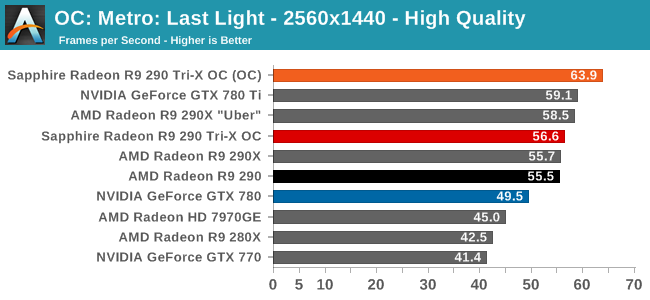
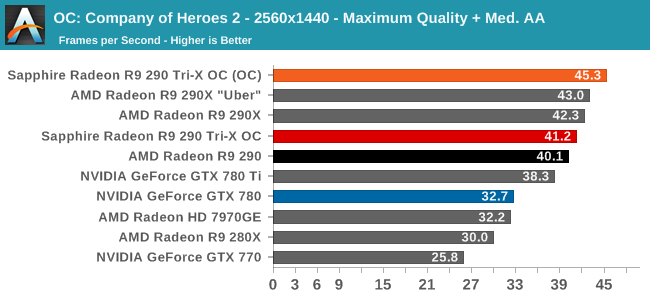
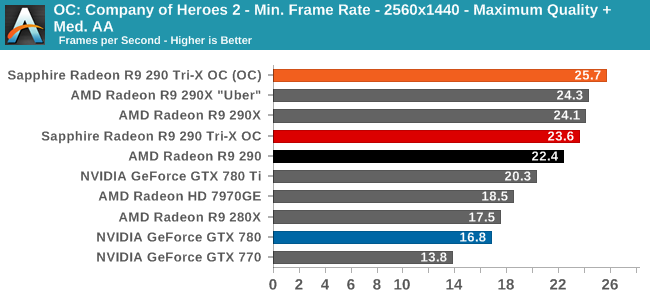
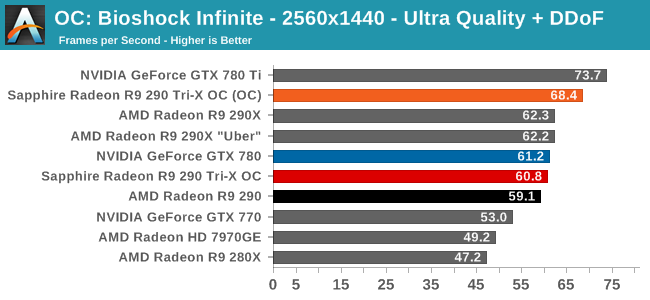
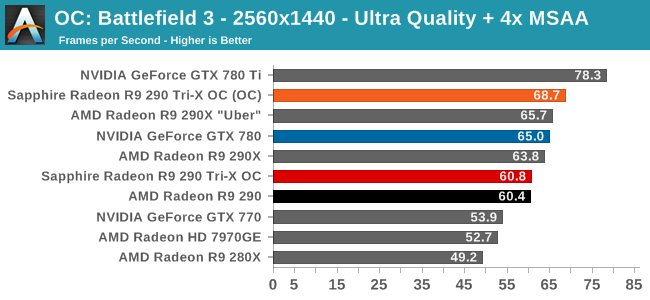
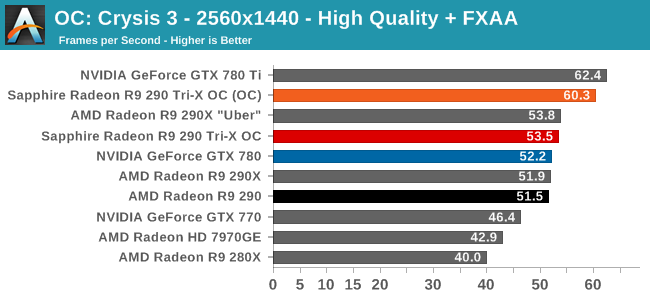
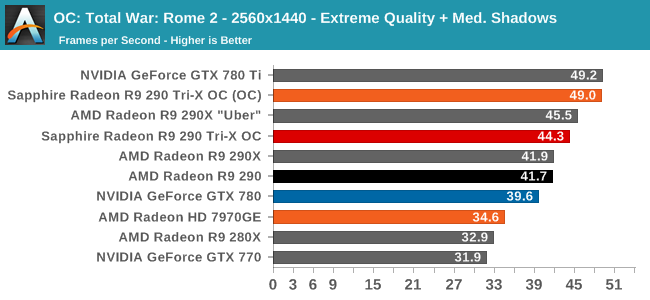
Starting first with gaming performance, as a more extensive overclock relative to Sapphire’s factory overclock, the performance gains from our own overclocking have yielded very solid results, despite the fact that this isn’t explicitly an overclocking board. Between the 13% core overclock and 15% memory overclock, the average performance increase measures in at 12%, varying depending on whether a game is more bandwidth limited, GPU limited, or CPU limited.
At 12% faster the overclocked 290 Tri-X OC is fast enough to largely close the gap between it and the reference GeForce GTX 780 Ti. Otherwise it will consistently outscore the 290X in “uber” mode, even in spite of the pared down nature of the Hawaii GPUs used in 290 cards.
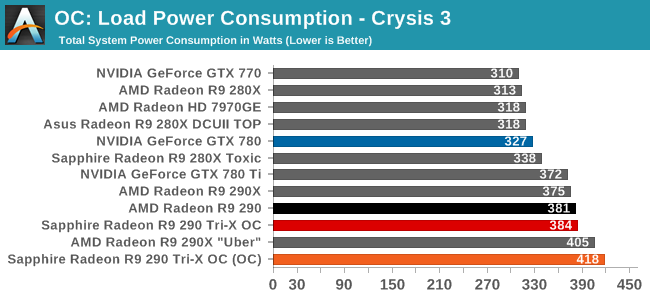
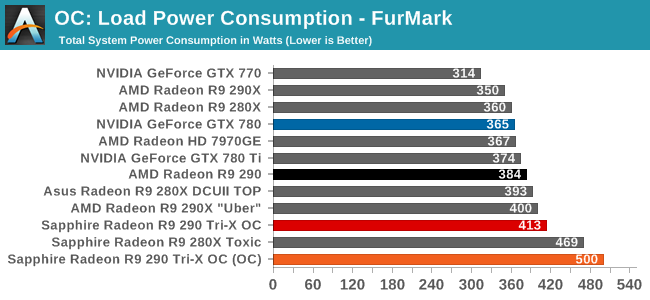
The power consumption penalty for overclocking is significant, but outside of the outright power limited FurMark, is not unreasonable. Under Crysis 3 the additional 13% in performance comes at a cost of 30W at the wall, most of which will be from the video card.
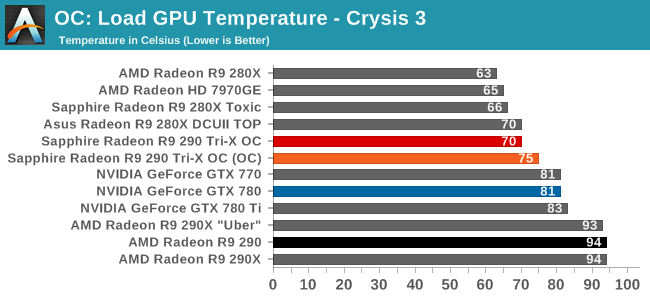

Along with power consumption overclocking also comes with the expected increase in operating temperatures. Under Crysis 3 this is an increase of 5C to 75C, while for FurMark (where the increase in power was greater) this is an additional 7C to 81C. FurMark definitely gives the Tri-X cooler a harder time when the video card is overclocked, but as this is a worst case scenario it also means that operating temperatures should still remain well under 80C, as evidenced by Crysis 3.

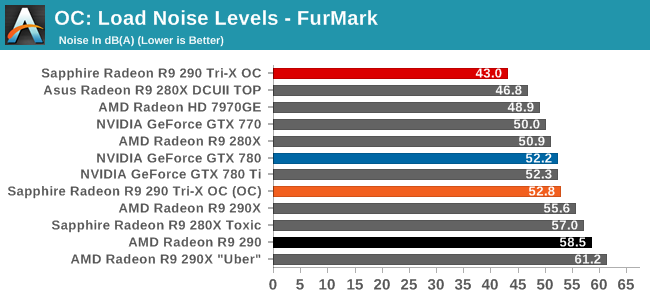
Even with our overclocking the 290 Tri-X OC still holds up rather well when it comes to Crysis 3. At 45.6dB this is a 4.5dB increase in noise, more than enough to be noticed, but notably it’s still quieter than our stock 280X and 7970GE, both of which are similarly open air coolers. FurMark on the other hand pushes the card much harder since it’s reaching the new 120% PowerTime power limit, leading to a jump in noise of just under 10dB to 52.8dB. Even faced with an overclocked FurMark the Tri-X cooler is still holding up very well, though we’ve clearly reached the point (with regards to thermal loads) where it has lost its near-silence.










119 Comments
View All Comments
Mondozai - Wednesday, December 25, 2013 - link
("That Ryan applied on this Sapphire 290", it should say at the end.)blanarahul - Wednesday, December 25, 2013 - link
Hexus.net are liers. Look at their Noise charts. Tri-X 290 is louder than a 780 Ti. Look at Anandtech or Computerbase.de, 290 Tri-X is quieter than 780 Ti.Mopar63 - Wednesday, December 25, 2013 - link
calling them liars might be harsh. There is no standardization in the review industry when it comes to how noise level is measured. Some use open bench and others use cases. The cases can vary with each model and then there is the fact that hardware and software used to measure can vary as well. Add to this the measuring methodology such as distance from the item as well as how ti was set to run, did they measure 100% speed, game play speeds, auto or set and so on.Bobs_Your_Uncle - Sunday, December 29, 2013 - link
Then there's always the question: are they recording the dB(A) measurements on a Metric scale or on an Imperial scale? : /bigboxes - Sunday, December 29, 2013 - link
LOLsheh - Wednesday, December 25, 2013 - link
I still don't understand why reference designs use blowers. Isn't that mainly useful for small cramped cases? Don't most users have a well-spaced case, and especially the users who go for high-end cards, and so are better served with an open air cooler?blanarahul - Wednesday, December 25, 2013 - link
These open air coolers dump heat/hot "inside" the case/cabinet. This has a negative impact on CPU, RAM, Chipset, HDD etc. temperatures (usless you are using a super tower). Blowers throw the hot air out the case and hence has no impact on other components.Open air coolers make a lot of sense for Open Air test benches though.
Mopar63 - Wednesday, December 25, 2013 - link
The impact of an open air cooler is a lot less on the systems internals than many think. The heat released is not a direct increase but rather like adding hot water to cooler water. The water is not suddenly hot, just a bit warmer. Also even mid and most mATX towers are moving more than enough air to make this a minor effect at best. In fact MANY of the mITX cases we are seeing for gaming rigs can handle it easily as well.Godigy - Wednesday, December 25, 2013 - link
Not necessarily. I had an R9 290 with the Gelid Icy aftermarket cooler, and if I didn't take the side panel off of my case, it would really make stuff in the case hot. My CPU temps jumped 10C with the side panel closed. If I were to open the side panel, I could feel the heat coming out of my case, which has very good airflow.Mayuyu - Wednesday, December 25, 2013 - link
I have one of these open air GPUs and I really don't like the design. The GPU board is so tall that it essentially creates another compartment in the case. Since the fan faces downward, all the heat is in the bottom of the case. The big fan at the back of the case only moves air for the CPU and RAM.